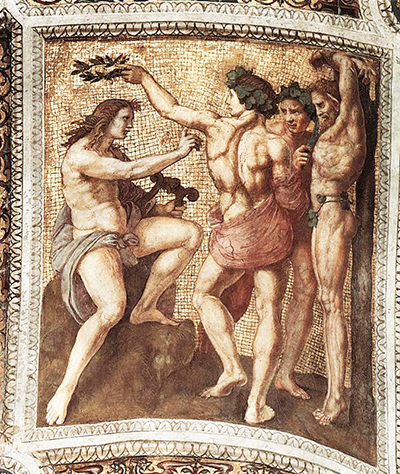As a High Renaissance artist, Raphael captured mythological episodes in the frescos painted in the Stanza Della Signatura (the Signature Room) of the Papal Palace in the Vatican.
Pope Julius II built the Stanza Della Signatura to serve as his personal library. He decided to decorate it in honour of the followers of the Church and past officers. So, the Pope commissioned Sanzio Raphael to perform a series of frescos which reflect 4 themes including theology, poetry, philosophy and justice. Apollo and Marsyas is the first fresco panel on the ceiling of the Signature Room right above the Parnassus. It's part of a series of 3 works associated with the Greek God Apollo. It illustrates a famous episode of Greek Mythology involving shepherd Marsyas and the God Apollo. Marsyas found the aulos which was tossed away by Greek Goddess Athena and became an expert at playing the instrument. He was so confident of his skills that he decided to challenge Apollo to a music contest. Apollo was famous for his mastery of the lyre.
Apollo accepted the challenge and organized the contest to be judged by 9 muses. However, because the muses were led by Apollo, they judged in his favour. Marsyas lost the music contest and was condemned to death. The myth depicts his death in a cave close to Calaenae in Phrygia. The Gods turned Marsyas's blood into a river. Raphael uses powerful contrasts to contour the 4 figures presented in the painting. With accurate and smooth strokes of oil paint he captures the dynamics and intensity of the scene illustrating Apollo's triumph. The fresco is an allegory for maintaining harmony and balance between the world of the Gods and that of the mortals. Marsyas's fierce character and confidence led him to overstep the law of the God's and condemned him to death.
While Apollo sits triumphant starring into the eyes of the mortal, Marsyas bows his head confirming his defeat. Raphael uses a constant interplay of shadows and lights to create the flow and movement of the act. Raphael's execution is immaculate and provides a clean integration of 2 main characters, namely Apollo and Marsyas and 2 subordinates. The warm colours which range within a palette of gold, brown and red reflect the intensity of the episode. The fresco located in the Palazzo Apostolico in the Vatican has a size of 120 x 105 cm and is part of Raphael's mythological paintings collection. Dated to around 1509-1511, the fresco was performed on the ceiling of the Signature Room in the Vatican Palace.
Apollo and Marsyas from the Stanza Della Signatura is an integral part of a larger collection of frescos executed by Sanzio Raphael. It reflects a very intense scene involving a musical competition between Apollo and the shepherd Marsyas. The fresco is an allegory for the importance of balance between the World of the Gods and that of the mortals. See also Titian's Flaying of Marsyas.




